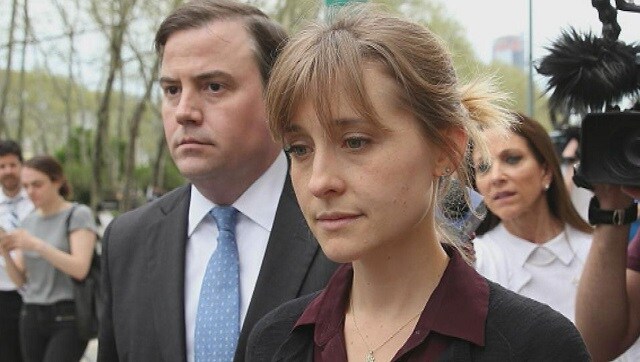Netflix true crime docu Why Did You Kill Me? raises more questions about justice, vengeance and vigilantism than it answers
The case the documentary explores is the 2006 murder of a 24-year-old Riverside, California, resident — Crystal Theobald — in a drive-by shooting near her home.

Poster for Why Did You Kill Me? | Netflix
Watching the new Netflix true crime documentary Why Did You Kill Me? is like entering a time capsule. A time when MySpace was the buzzing new social media platform that everyone and their cousin wanted to hang out at. The case the documentary explores is the 2006 murder of a 24-year-old Riverside, California, resident — Crystal Theobald — in a drive-by shooting near her home.
Crystal, recently separated from her husband who'd relapsed into a drug addiction, had got into a car with her mother and brother for a ride to the grocery store when just a few metres down the road, their car was caught in a shootout. A bullet hit Crystal in the back of her head. CCTV footage shows the family's car stopping by a storefront, her brother carrying Crystal out in his arms and sobbing over her limp form. She was rushed to the hospital, where she died.
Her family was devastated. The police canvassed the neighbourhood for clues, thoroughly scrutinised the crime scene. There were some leads. Until this point, it all comes across as yet another tragic, cookie-cutter shooting incident.
Why Did You Kill Me? then takes the first of its unexpected turns: Crystal's mother Belinda Lane was not exactly cooperative with the authorities, neither were her brothers entirely forthcoming. The lead detective on the case describes the family's lack of trust in the cops. With reason, as it turns out: Belinda and her two older sons had rap sheets for various crimes; Belinda used — and sold — meth. Further, Crystal's older brother Rob was involved in a chase with the gang members who ultimately fired the shots that accidentally killed his sister.
As the police try to unravel these new threads, one name comes up repeatedly — the 5150 (fifty-one fifty), a gang based in Riverside with mostly Hispanic members. But with few new details forthcoming, Belinda decided to take matters into her own hand.
This is the second of Why Did You Kill Me?'s twists: Belinda got Crystal's younger cousin Jaimie, then 14, to set up two fake MySpace accounts and befriend 5150 members online. One of the catfish accounts they used had photos of Crystal, with Jaimie channeling her cousin's personality using the pseudonym 'Angel' in chats with 5150 members. Angel became popular with 5150 members, but especially with one called William "Jokes" Sotelo, 18, whose messages were tender and caring, indicating a desire to meet with her in person.
A synopsis for Why Did You Kill Me? states that it explores the space between justice, vengeance and vigilantism. Crystal's story does have those elements, but the documentary offers only a superficial view of these aspects. For most of Jaimie's recounting of how she catfished the 5150 members, there's a lot of focus on the mechanics of it: how she'd spend hours online — from 3 in the afternoon, as soon as she got home from school, to 1 in the night, chatting with these gang members, pretending to be two women she was not. Belinda urged her to keep at it, mine for as much information as she could. She may have been a bereaved mother, but doesn’t seem to have had any second thoughts about egging on her 14-year-old niece to chat up gang members online. As for how Jaimie actually felt about it, all we get is a brief statement that "it didn't feel good" to pretend to be her dead cousin, and how while she was chatting as Angel, Jaimie felt she was able to keep Crystal alive. How might that experience have impacted a teenaged girl?
We do find out that after a while, it got too much for Jaimie, who turned over access to the MySpace profiles to Belinda. Before she did so, Jaimie uncovered a clue: Jokes/Sotelo owned a white Ford Expedition SUV — the same make of car Crystal's assailants had been seen in. A police interview with Sotelo gleaned some details about the shootout, but since he hadn't been called in as an official suspect, the cops had to let Jokes go. An enraged Belinda confronted him over Angel's MySpace chat, and began messaging rival gang members with made-up insults she said Sotelo had levied. There was a spate of attacks against white SUVs even as Sotelo vanished without a trace. Meanwhile, Belinda announced plans to host a "party" in a deserted location, where she meant to shoot at gang members as they drove in. Her family was able to dissuade her from pursuing this course of action. Again, this is all presented as matter of fact, with no examination of the implications of this kind of vigilantism.
The police did eventually track down and prosecute Crystal's killer, with the help of two other witnesses present that night, both members of 5150. The killer was sentenced to life without parole. His statement about the shootout brings forth the full futility and randomness of Crystal's death: rumours about a rival gang on the attack, the chase with Crystal's older brother Rob, the stray gunshot that wasn't even meant for Crystal. And as friends and relatives of the killer speak about the circumstances of his upbringing and how he and others like him were initiated as young boys into 5150, you get a sense of the futility and randomness of his life.
The origins of 5150 read like a tragedy: of youngsters in the poor La Sierra neighbourhood of Riverside (which one former gang member describes as a place where the outcasts from LA and the Orange County settled), with lack of opportunities and a gang that let them feel like part of a tight-knit, powerful fraternity whilst exposing them to a life of escalating violence. Again, Why Did You Kill Me? barely lays out the outlines of this story before it too is quickly wrapped up. The debate over gun control laws in the US is not brought up.
The documentary has a third and final twist: one with an element of redemption. It is also the only aspect that feels somewhat satisfying in terms of how it has been explored. At just about an hour and 20 minutes, Why Did You Kill Me? (directed by Fredrick Munk) is a quick watch; however, while the story itself doesn't lack nuance, there is an incompleteness to the way in which those nuances are depicted. The people and the events in which they were involved admit for plenty of greys; instead, these too are depicted in an almost pedestrian manner. In their place, the documentary expends a large part of its focus on recreating the events of the night of Crystal's shooting, with all the principal folks stepping up to a miniature model of the street on which it occurred and moving toy cars around for a step-by-step replay. Recreations of Jaimie and Belinda's MySpace catfishing, police recordings of interviews with witnesses and suspects, on camera interviews and some archival photos drive the rest of the narrative.
Why Did You Kill Me? also chooses to end — somewhat questionably — on a visual of Belinda reading from tarot cards and predicting that Sotelo (an accomplice in Crystal's killing) will be brought to justice. (The documentary informs us that Sotelo, missing for 14 years, was traced in Mexico and apprehended.) "Justice is vengeance," Belinda declares. But is it? Is justice only retribution? And is retribution the same as revenge? It seems like the documentary wants us to know that the answer to these questions is “no”. Why it then chooses a concluding quote that emphasises otherwise is confusing indeed.
Why Did You Kill Me? is now streaming on Netflix. Watch the trailer here —
also read

The Kitchen movie review: Melissa McCarthy, Tiffany Haddish, Elizabeth Moss' mob drama feels like a gang spoof gone wrong
The Kitchen's simplistic, black-and-white narrative ends up being a feeble attempt at a snazzy female mob film, with the shadow of far better works (The Godfather, anyone?) looming large over it.

Searching For Sheela trailer: Netflix docu-film puts spotlight on Ma Anand Sheela's controversial life
Searching for Sheela, due on 22 April on Netflix, traces her journey through India and sheds light on her new life post serving time for her alleged crimes.

Seduced: Inside the NXIVM Cult compellingly explores mechanics of brainwashing and foregrounds survivors' stories
Over the course of four hour-long episodes, the docuseries delves into the trafficking and psychological and physical abuse of women that occurred at NXIVM, not just at the hands of its founder Keith Raniere, but also his most devoted acolytes, like Smallville actress Allison Mack.

